2002 DODGE RAM differential
[x] Cancel search: differentialPage 89 of 2255
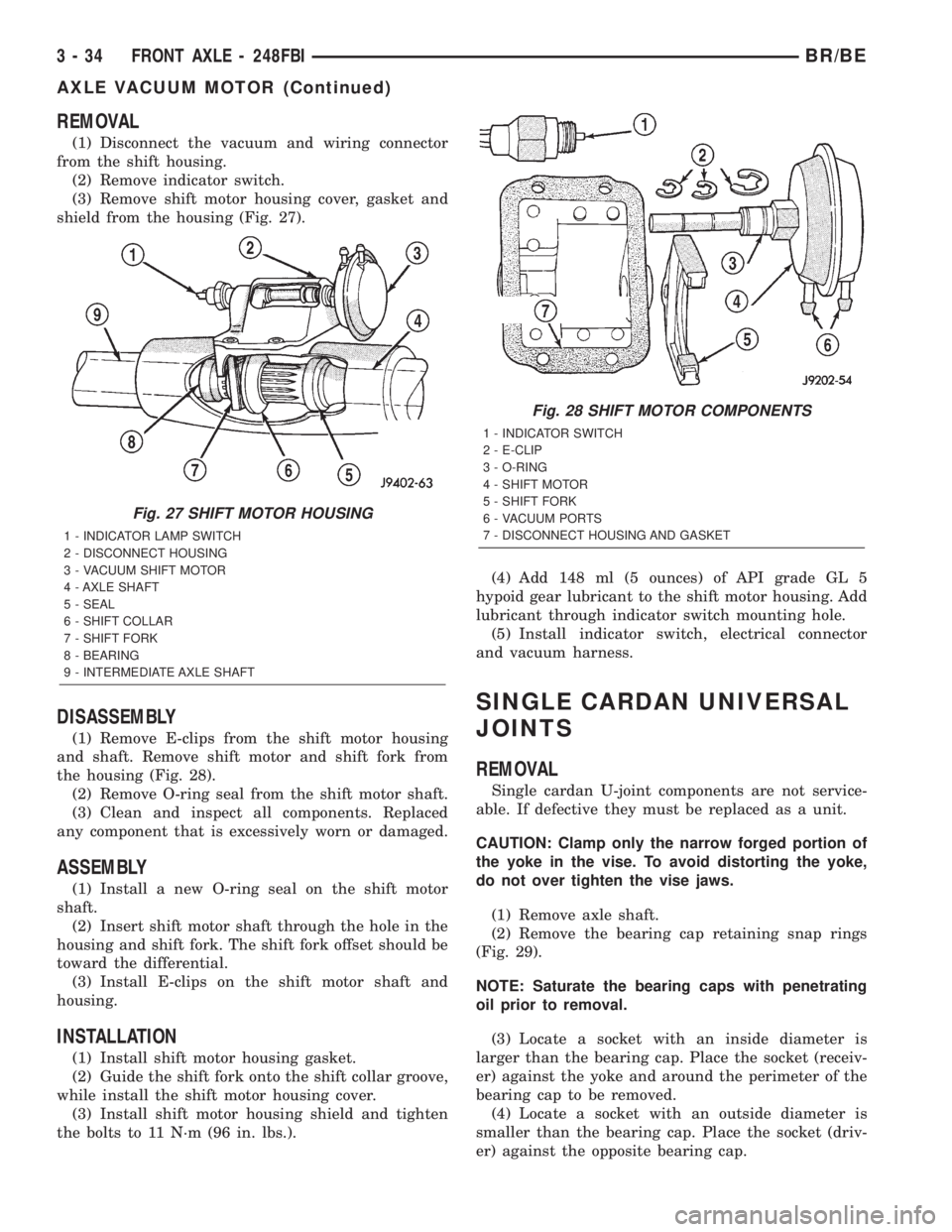
REMOVAL
(1) Disconnect the vacuum and wiring connector
from the shift housing.
(2) Remove indicator switch.
(3) Remove shift motor housing cover, gasket and
shield from the housing (Fig. 27).
DISASSEMBLY
(1) Remove E-clips from the shift motor housing
and shaft. Remove shift motor and shift fork from
the housing (Fig. 28).
(2) Remove O-ring seal from the shift motor shaft.
(3) Clean and inspect all components. Replaced
any component that is excessively worn or damaged.
ASSEMBLY
(1) Install a new O-ring seal on the shift motor
shaft.
(2) Insert shift motor shaft through the hole in the
housing and shift fork. The shift fork offset should be
toward the differential.
(3) Install E-clips on the shift motor shaft and
housing.
INSTALLATION
(1) Install shift motor housing gasket.
(2) Guide the shift fork onto the shift collar groove,
while install the shift motor housing cover.
(3) Install shift motor housing shield and tighten
the bolts to 11 N´m (96 in. lbs.).(4) Add 148 ml (5 ounces) of API grade GL 5
hypoid gear lubricant to the shift motor housing. Add
lubricant through indicator switch mounting hole.
(5) Install indicator switch, electrical connector
and vacuum harness.
SINGLE CARDAN UNIVERSAL
JOINTS
REMOVAL
Single cardan U-joint components are not service-
able. If defective they must be replaced as a unit.
CAUTION: Clamp only the narrow forged portion of
the yoke in the vise. To avoid distorting the yoke,
do not over tighten the vise jaws.
(1) Remove axle shaft.
(2) Remove the bearing cap retaining snap rings
(Fig. 29).
NOTE: Saturate the bearing caps with penetrating
oil prior to removal.
(3) Locate a socket with an inside diameter is
larger than the bearing cap. Place the socket (receiv-
er) against the yoke and around the perimeter of the
bearing cap to be removed.
(4) Locate a socket with an outside diameter is
smaller than the bearing cap. Place the socket (driv-
er) against the opposite bearing cap.
Fig. 27 SHIFT MOTOR HOUSING
1 - INDICATOR LAMP SWITCH
2 - DISCONNECT HOUSING
3 - VACUUM SHIFT MOTOR
4 - AXLE SHAFT
5 - SEAL
6 - SHIFT COLLAR
7 - SHIFT FORK
8 - BEARING
9 - INTERMEDIATE AXLE SHAFT
Fig. 28 SHIFT MOTOR COMPONENTS
1 - INDICATOR SWITCH
2 - E-CLIP
3 - O-RING
4 - SHIFT MOTOR
5 - SHIFT FORK
6 - VACUUM PORTS
7 - DISCONNECT HOUSING AND GASKET
3 - 34 FRONT AXLE - 248FBIBR/BE
AXLE VACUUM MOTOR (Continued)
Page 92 of 2255
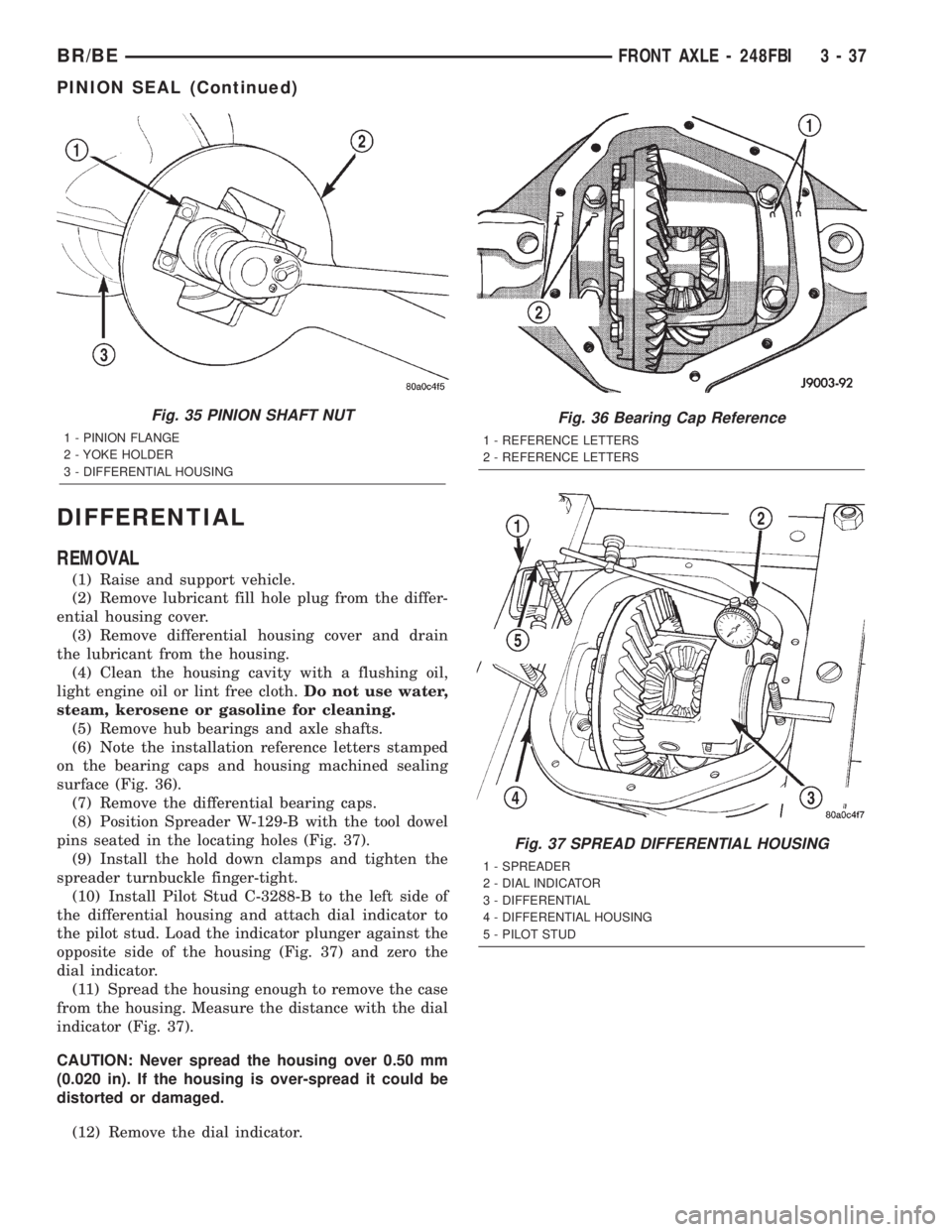
DIFFERENTIAL
REMOVAL
(1) Raise and support vehicle.
(2) Remove lubricant fill hole plug from the differ-
ential housing cover.
(3) Remove differential housing cover and drain
the lubricant from the housing.
(4) Clean the housing cavity with a flushing oil,
light engine oil or lint free cloth.Do not use water,
steam, kerosene or gasoline for cleaning.
(5) Remove hub bearings and axle shafts.
(6) Note the installation reference letters stamped
on the bearing caps and housing machined sealing
surface (Fig. 36).
(7) Remove the differential bearing caps.
(8) Position Spreader W-129-B with the tool dowel
pins seated in the locating holes (Fig. 37).
(9) Install the hold down clamps and tighten the
spreader turnbuckle finger-tight.
(10) Install Pilot Stud C-3288-B to the left side of
the differential housing and attach dial indicator to
the pilot stud. Load the indicator plunger against the
opposite side of the housing (Fig. 37) and zero the
dial indicator.
(11) Spread the housing enough to remove the case
from the housing. Measure the distance with the dial
indicator (Fig. 37).
CAUTION: Never spread the housing over 0.50 mm
(0.020 in). If the housing is over-spread it could be
distorted or damaged.
(12) Remove the dial indicator.
Fig. 35 PINION SHAFT NUT
1 - PINION FLANGE
2 - YOKE HOLDER
3 - DIFFERENTIAL HOUSING
Fig. 36 Bearing Cap Reference
1 - REFERENCE LETTERS
2 - REFERENCE LETTERS
Fig. 37 SPREAD DIFFERENTIAL HOUSING
1 - SPREADER
2 - DIAL INDICATOR
3 - DIFFERENTIAL
4 - DIFFERENTIAL HOUSING
5 - PILOT STUD
BR/BEFRONT AXLE - 248FBI 3 - 37
PINION SEAL (Continued)
Page 93 of 2255
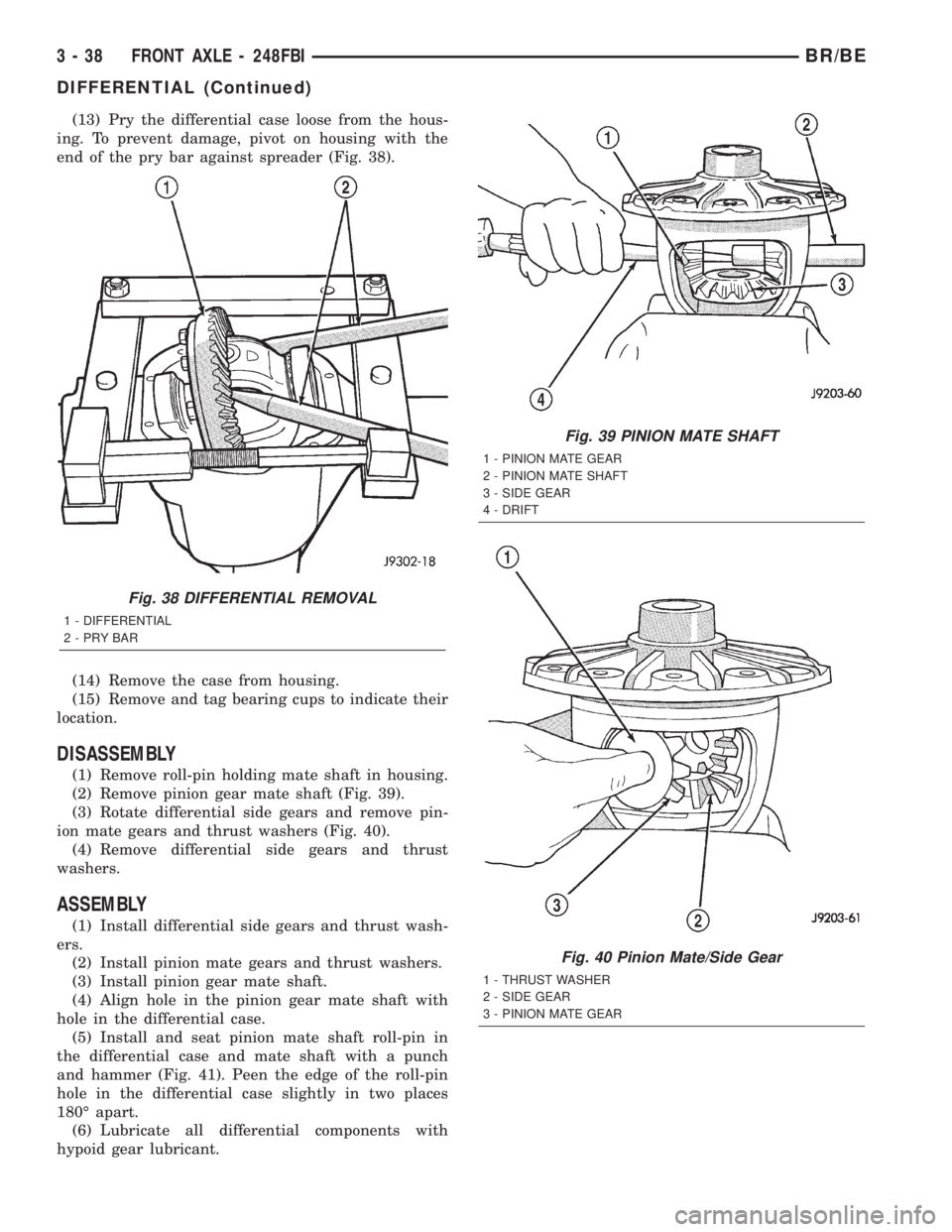
(13) Pry the differential case loose from the hous-
ing. To prevent damage, pivot on housing with the
end of the pry bar against spreader (Fig. 38).
(14) Remove the case from housing.
(15) Remove and tag bearing cups to indicate their
location.
DISASSEMBLY
(1) Remove roll-pin holding mate shaft in housing.
(2) Remove pinion gear mate shaft (Fig. 39).
(3) Rotate differential side gears and remove pin-
ion mate gears and thrust washers (Fig. 40).
(4) Remove differential side gears and thrust
washers.
ASSEMBLY
(1) Install differential side gears and thrust wash-
ers.
(2) Install pinion mate gears and thrust washers.
(3) Install pinion gear mate shaft.
(4) Align hole in the pinion gear mate shaft with
hole in the differential case.
(5) Install and seat pinion mate shaft roll-pin in
the differential case and mate shaft with a punch
and hammer (Fig. 41). Peen the edge of the roll-pin
hole in the differential case slightly in two places
180É apart.
(6) Lubricate all differential components with
hypoid gear lubricant.
Fig. 38 DIFFERENTIAL REMOVAL
1 - DIFFERENTIAL
2-PRYBAR
Fig. 39 PINION MATE SHAFT
1 - PINION MATE GEAR
2 - PINION MATE SHAFT
3 - SIDE GEAR
4 - DRIFT
Fig. 40 Pinion Mate/Side Gear
1 - THRUST WASHER
2 - SIDE GEAR
3 - PINION MATE GEAR
3 - 38 FRONT AXLE - 248FBIBR/BE
DIFFERENTIAL (Continued)
Page 94 of 2255

INSTALLATION
NOTE: If replacement differential bearings or differ-
ential case are being installed, differential side
bearing shim requirements may change. Refer to
Adjustments (Differential Bearing Preload and Gear
Backlash) procedures to determine proper shim
selection.
(1) Position Spreader W-129-B with the tool dowel
pins seated in the locating holes. Install the hold
down clamps and tighten the tool turnbuckle finger-
tight.
(2) Install a Pilot Stud C-3288-B at the left side of
the differential housing and attach dial indicator to
the pilot stud. Load the indicator plunger against the
opposite side of the housing and zero the dial indica-
tor.
(3) Spread the housing enough to install the case
in the housing. Measure the distance with the dial
indicator.
CAUTION: Never spread the housing over 0.50 mm
(0.020 in). If housing is over-spread, it could be dis-
torted or damaged.
(4) Remove the dial indicator.(5) Install differential into the housing. Tap the
differential case with a rawhide/rubber hammer to
ensure the bearings are seated in housing (Fig. 42).
(6) Remove the spreader.
(7) Install bearing caps in their original locations
(Fig. 43) and tighten bearing cap bolts in a criss-
cross pattern to 109 N´m (80 ft. lbs.).
(8) Install axle shafts.
(9) Install the hub bearings.
Fig. 41 Pinion Mate Shaft Roll-Pin
1 - PUNCH
2 - PINION MATE SHAFT
3 - MATE SHAFT LOCKPIN
Fig. 42 DIFFERENTIAL CASE
1 - RAWHIDE HAMMER
Fig. 43 Bearing Cap Reference
1 - REFERENCE LETTERS
2 - REFERENCE LETTERS
BR/BEFRONT AXLE - 248FBI 3 - 39
DIFFERENTIAL (Continued)
Page 95 of 2255

(10) Apply a bead of red Mopar Silicone Rubber
Sealant or equivalent to the housing cover (Fig. 44).
CAUTION: If housing cover is not installed within 3
to 5 minutes, the cover must be cleaned and new
RTV applied or adhesion quality will be compro-
mised.
(11) Install the cover and tighten bolts in a criss-
cross pattern to 47 N´m (35 ft. lbs.).
(12) Fill the differential with Mopar Hypoid Gear
Lubricant or equivalent to bottom of the fill plug
hole.
(13) Install fill hole plug and tighten to 34 N´m (25
ft. lbs.).
(14) Remove support and lower vehicle.DIFFERENTIAL CASE
BEARINGS
REMOVAL
(1) Remove differential case from axle housing.
(2) Remove bearings from the differential case
with Puller/Press C-293-PA, Adapters C-293-62 and
Step Plate C-4487-1 (Fig. 45).
Fig. 44 DIFFERENTIAL COVER - TYPICAL
1 - SEALANT SURFACE
2 - SEALANT
3 - SEALANT THICKNESS
Fig. 45 Differential Bearing Removal
1 - PULLER
2 - ADAPTERS
3 - STEP PLATE
4 - BEARING
5 - DIFFERENTIAL CASE
3 - 40 FRONT AXLE - 248FBIBR/BE
DIFFERENTIAL (Continued)
Page 96 of 2255
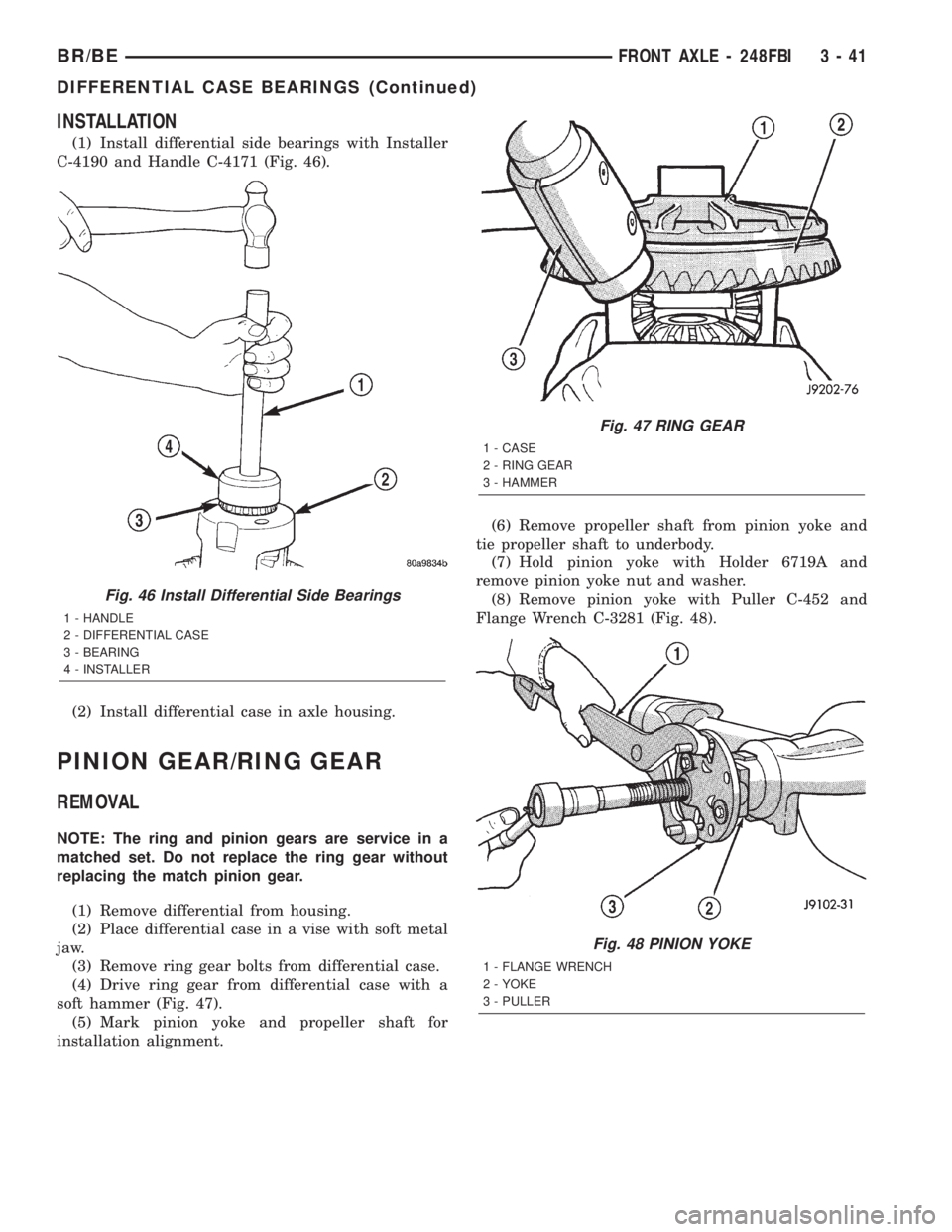
INSTALLATION
(1) Install differential side bearings with Installer
C-4190 and Handle C-4171 (Fig. 46).
(2) Install differential case in axle housing.
PINION GEAR/RING GEAR
REMOVAL
NOTE: The ring and pinion gears are service in a
matched set. Do not replace the ring gear without
replacing the match pinion gear.
(1) Remove differential from housing.
(2) Place differential case in a vise with soft metal
jaw.
(3) Remove ring gear bolts from differential case.
(4) Drive ring gear from differential case with a
soft hammer (Fig. 47).
(5) Mark pinion yoke and propeller shaft for
installation alignment.(6) Remove propeller shaft from pinion yoke and
tie propeller shaft to underbody.
(7) Hold pinion yoke with Holder 6719A and
remove pinion yoke nut and washer.
(8) Remove pinion yoke with Puller C-452 and
Flange Wrench C-3281 (Fig. 48).
Fig. 46 Install Differential Side Bearings
1 - HANDLE
2 - DIFFERENTIAL CASE
3 - BEARING
4 - INSTALLER
Fig. 47 RING GEAR
1 - CASE
2 - RING GEAR
3 - HAMMER
Fig. 48 PINION YOKE
1 - FLANGE WRENCH
2 - YOKE
3 - PULLER
BR/BEFRONT AXLE - 248FBI 3 - 41
DIFFERENTIAL CASE BEARINGS (Continued)
Page 100 of 2255

(11) Install yoke washer and anewnut on the
pinion gear. Tighten the nut to 291 N´m (215 ft. lbs.)
minimum.Do not over±tighten.Maximum torque
is 678 N´m (500 ft. lbs.).
CAUTION: Never loosen pinion gear nut to decrease
pinion preload torque and never exceed specified
preload torque. If preload torque is exceeded a new
collapsible spacer must be installed.
(12) Use Yoke Holder 6719A to hold the yoke (Fig.
60) and tighten the nut in 6.8 N´m (5 ft. lbs.) until
the rotating torque is achieved. Measure the preload
torque frequently to avoid over-tightening the nut.
(13) Check bearing preload torque with an inch
pound torque wrench (Fig. 61). The torque to rotate
the pinion gear should be:
²Original Bearings: 1 to 2 N´m (10 to 20 in. lbs.).
²New Bearings: 2.26 to 4.52 N´m (20 to 40 in.
lbs.).
(14) Invert differential case in a vise and start two
ring gear bolts. This will provide case-to-ring gear
bolt hole alignment.
(15) Installnewring gear bolts and alternately
tighten to 176 N´m (130 ft. lbs.). (Fig. 62).
CAUTION: Never reuse the ring gear bolts. The
bolts can fracture causing extensive damage.
(16) Install differential in axle housing and verify
gear mesh and contact pattern. Refer to Adjustments
(Gear Contact Pattern).
(17) Install differential cover and fill with lubri-
cant.
Fig. 60 PINION NUT
1 - PINION FLANGE
2 - YOKE HOLDING
3 - DIFFERENTIAL HOUSING
Fig. 61 Pinion Rotating Torque
1 -TORQUE WRENCH
2 - PINION YOKE
Fig. 62 RING GEAR BOLT
1 - TORQUE WRENCH
2 - RING GEAR BOLT
3 - RING GEAR
4 - CASE
BR/BEFRONT AXLE - 248FBI 3 - 45
PINION GEAR/RING GEAR (Continued)
Page 101 of 2255
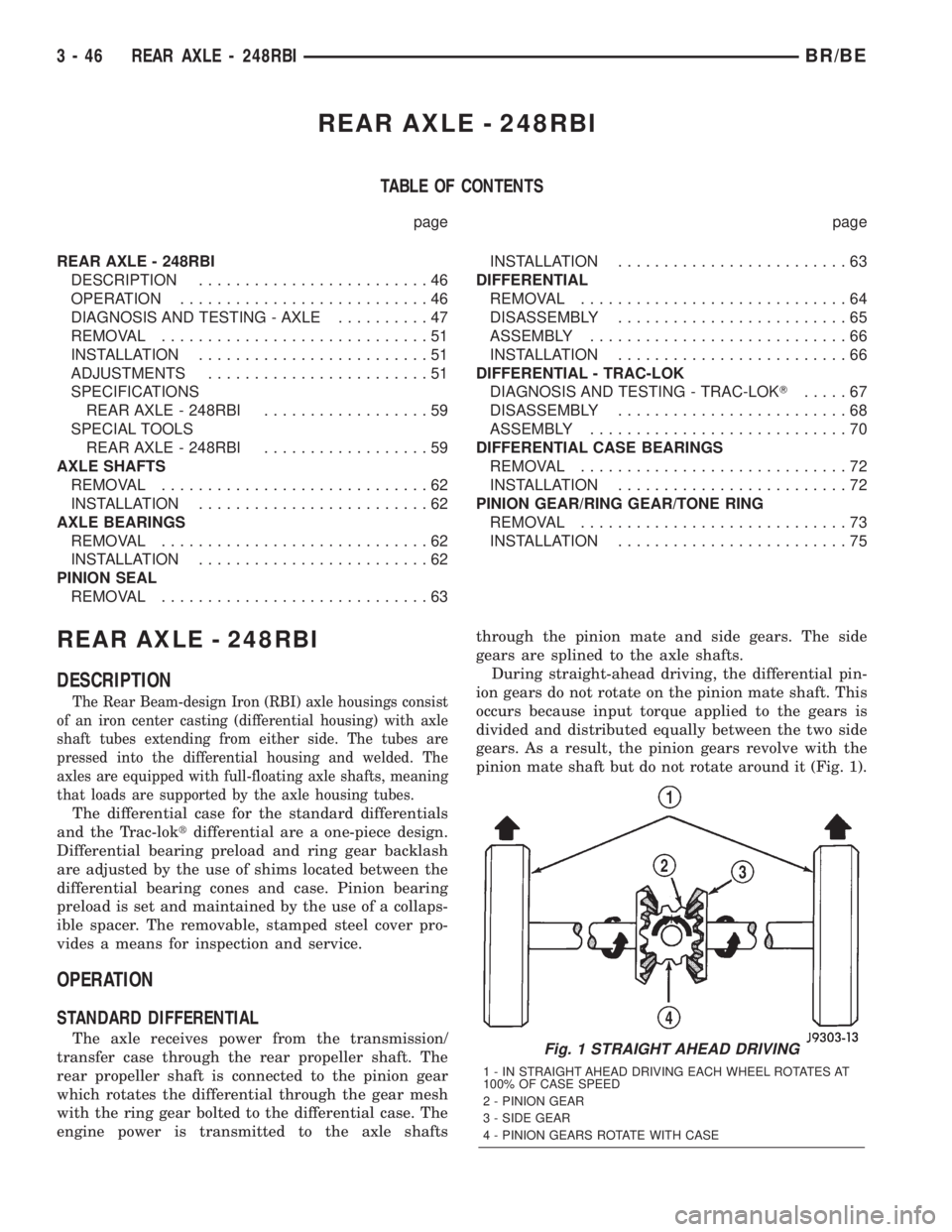
REAR AXLE - 248RBI
TABLE OF CONTENTS
page page
REAR AXLE - 248RBI
DESCRIPTION.........................46
OPERATION...........................46
DIAGNOSIS AND TESTING - AXLE..........47
REMOVAL.............................51
INSTALLATION.........................51
ADJUSTMENTS........................51
SPECIFICATIONS
REAR AXLE - 248RBI..................59
SPECIAL TOOLS
REAR AXLE - 248RBI..................59
AXLE SHAFTS
REMOVAL.............................62
INSTALLATION.........................62
AXLE BEARINGS
REMOVAL.............................62
INSTALLATION.........................62
PINION SEAL
REMOVAL.............................63INSTALLATION.........................63
DIFFERENTIAL
REMOVAL.............................64
DISASSEMBLY.........................65
ASSEMBLY............................66
INSTALLATION.........................66
DIFFERENTIAL - TRAC-LOK
DIAGNOSIS AND TESTING - TRAC-LOKT.....67
DISASSEMBLY.........................68
ASSEMBLY............................70
DIFFERENTIAL CASE BEARINGS
REMOVAL.............................72
INSTALLATION.........................72
PINION GEAR/RING GEAR/TONE RING
REMOVAL.............................73
INSTALLATION.........................75
REAR AXLE - 248RBI
DESCRIPTION
The Rear Beam-design Iron (RBI) axle housings consist
of an iron center casting (differential housing) with axle
shaft tubes extending from either side. The tubes are
pressed into the differential housing and welded. The
axles are equipped with full-floating axle shafts, meaning
that loads are supported by the axle housing tubes.
The differential case for the standard differentials
and the Trac-loktdifferential are a one-piece design.
Differential bearing preload and ring gear backlash
are adjusted by the use of shims located between the
differential bearing cones and case. Pinion bearing
preload is set and maintained by the use of a collaps-
ible spacer. The removable, stamped steel cover pro-
vides a means for inspection and service.
OPERATION
STANDARD DIFFERENTIAL
The axle receives power from the transmission/
transfer case through the rear propeller shaft. The
rear propeller shaft is connected to the pinion gear
which rotates the differential through the gear mesh
with the ring gear bolted to the differential case. The
engine power is transmitted to the axle shaftsthrough the pinion mate and side gears. The side
gears are splined to the axle shafts.
During straight-ahead driving, the differential pin-
ion gears do not rotate on the pinion mate shaft. This
occurs because input torque applied to the gears is
divided and distributed equally between the two side
gears. As a result, the pinion gears revolve with the
pinion mate shaft but do not rotate around it (Fig. 1).Fig. 1 STRAIGHT AHEAD DRIVING
1 - IN STRAIGHT AHEAD DRIVING EACH WHEEL ROTATES AT
100% OF CASE SPEED
2 - PINION GEAR
3 - SIDE GEAR
4 - PINION GEARS ROTATE WITH CASE
3 - 46 REAR AXLE - 248RBIBR/BE